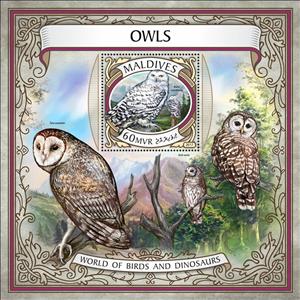Souvenir Sheet: Owls (Maldives 2017)
Owls (Maldives 2017)
17 May (Maldives ) within release Owls goes into circulation Souvenir Sheet Owls face value 60 Maldivian rufiyaa
| Souvenir Sheet Owls in catalogues | |
|---|---|
| Michel: | Mi: MV BL1074 |
Souvenir Sheet is square format.
Although this issue was authorized by postal officials in the Maldives, the entire issue was distributed by the stamp agents representing the Maldives to the new issued trade, and not sold in the Maldives.Also in the issue Owls:
- Mini Sheet - Owls face value 4*20;
- Stamp - Strix varia face value 20;
- Stamp - Ptilopsis leucotis face value 20;
- Stamp - Bubo scandiacus face value 60;
- Stamp - Tyto novaehollandiae melvillensis face value 20;
- Stamp - Tyto alba face value 20;
- Souvenir Sheet - Owls face value 60;
Souvenir Sheet Owls it reflects the thematic directions:
Animals are multicellular, eukaryotic organisms of the kingdom Animalia (also called Metazoa). All animals are motile, meaning they can move spontaneously and independently, at some point in their lives. Their body plan eventually becomes fixed as they develop, although some undergo a process of metamorphosis later on in their lives. All animals are heterotrophs: they must ingest other organisms or their products for sustenance.
Birds (Aves), a subgroup of Reptiles, are the last living examples of Dinosaurs. They are a group of endothermic vertebrates, characterised by feathers, toothless beaked jaws, the laying of hard-shelled eggs, a high metabolic rate, a four-chambered heart, and a strong yet lightweight skeleton. Birds live worldwide and range in size from the 5 cm (2 in) bee hummingbird to the 2.75 m (9 ft) ostrich. They rank as the class of tetrapods with the most living species, at approximately ten thousand, with more than half of these being passerines, sometimes known as perching birds. Birds are the closest living relatives of crocodilians.
Birds of prey or predatory birds, also known as raptors, are hypercarnivorous bird species that actively hunt and feed on other vertebrates (mainly mammals, reptiles and smaller birds). In addition to speed and strength, these predators have keen eyesight for detecting prey from a distance or during flight, strong feet with sharp talons for grasping or killing prey, and powerful, curved beaks for tearing off flesh. Although predatory birds primarily hunt live prey, many species (such as fish eagles, vultures and condors) also scavenge and eat carrion
Owls are birds from the order Strigiformes, which includes over 200 species of mostly solitary and nocturnal birds of prey typified by an upright stance, a large, broad head, binocular vision, binaural hearing, sharp talons, and feathers adapted for silent flight. Exceptions include the diurnal northern hawk-owl and the gregarious burrowing owl.




